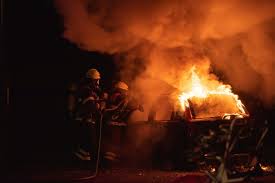For many veterans, the challenges of military service don’t end on the battlefield. In recent years, a new threat has emerged: exposure to aqueous film-forming foam (AFFF), a firefighting agent linked to severe health issues.
As veterans grapple with the consequences of AFFF exposure, navigating the VA claims process adds even more complexity to their journey toward seeking support.
Understanding AFFF and Its Health Risks
AFFF, developed in the 1960s, revolutionized firefighting due to its ability to rapidly extinguish fuel fires. However, ITRC notes that its key ingredient, PFAS, has since been identified as persistent organic pollutants that accumulate in the environment and human body.
Veterans who worked as aircraft mechanics, firefighters, or in other roles where AFFF was routinely used are at heightened risk of exposure. The health risks associated with PFAS include increased cholesterol levels, liver damage, and certain cancers like kidney and testicular cancer.
The Burden on Veterans
Beyond the physical toll, AFFF exposure imposes significant emotional and financial burdens on veterans and their families. Many veterans face uncertainty about their health and future, leading to anxiety and depression.
Moreover, managing chronic health conditions often requires costly medical treatments and medications, straining already limited finances. Relationships may suffer as veterans cope with the impact of their health issues, leading to feelings of isolation and alienation.
FOR MORE INFORMATION CLICK HERE : unique experience gifts for her
Pursuing Legal Recourse
In addition to navigating VA claims for exposure to AFFF, veterans are turning to the legal system to seek compensation for AFFF-related health issues. Lawsuits against manufacturers of AFFF products allege negligence and failure to warn about the health risks associated with PFAS exposure. As per a May 2024 update from the Lawsuit Information Center, the number of pending AFFF claims has gone past 8,000.
According to TorHoerman Law, these legal actions aim to hold responsible parties accountable for the harm caused to veterans and their families. While legal recourse may offer an alternative path to obtaining compensation, it also entails its own set of challenges. This includes things such as lengthy litigation processes and uncertain outcomes.
Challenges in Establishing Service Connection
Establishing a direct link between AFFF exposure during military service and subsequent health conditions presents a formidable challenge for veterans seeking VA benefits. Unlike injuries sustained in combat, the effects of toxic exposure often manifest years or even decades later.
Gathering sufficient evidence to prove exposure and causation requires meticulous documentation of service history, medical records, and environmental exposure data. Additionally, the lack of standardized protocols for assessing PFAS exposure complicates the process further.
Delays and Denials
Despite compelling evidence, many veterans encounter delays and denials in their VA claims for AFFF-related health conditions. The backlog of claims and bureaucratic red tape contribute to lengthy wait times for adjudication.
Moreover, the complexity of proving causation and the subjective nature of disability assessments can result in inconsistent outcomes. For veterans already grappling with health challenges, these delays and denials exacerbate their distress and hinder access to vital resources and support.
Advocating for Change
Veterans and advocacy groups are actively lobbying for reforms to address the shortcomings of the VA claims process for AFFF exposure. As per The Big Red Guide, the Fire Fighting Foam Coalition (FFFC) is one such non-profit advocacy group. Legislative efforts seek to streamline the claims process, improve access to healthcare services, and expand research into PFAS-related health effects.
Additionally, increased public awareness and media attention are crucial for garnering support and driving policy changes. By amplifying the voices of affected veterans, advocates strive to ensure that those who served receive the care and compensation they deserve.
FAQs
Is AFFF still being used?
Yes, aqueous film-forming foam (AFFF) is still being used in certain firefighting applications due to its effectiveness in combating certain types of fires. However, there’s growing awareness of its environmental impact, leading to efforts to find alternatives and regulate its use.
How does AFFF work?
Aqueous film-forming foam (AFFF) forms a film on the surface of flammable liquids, suppressing vapor and preventing re-ignition. The foam also cools the fuel, cutting off the oxygen supply and extinguishing the fire.
What type of fire is AFFF typically used on?
AFFF is primarily used on Class B fires, which involve flammable liquids such as gasoline, diesel, oil, and solvents. It is effective in forming a blanket over the liquid’s surface, preventing the release of flammable vapors and extinguishing the fire.
In conclusion, the journey of veterans facing AFFF exposure reveals a narrative of resilience amidst adversity. Their struggles underscore systemic shortcomings in providing timely support and recognition. Yet, amidst the challenges, advocacy, legal actions, and legislative endeavors offer hope for reform.
By standing in solidarity, we can honor their sacrifices, ensuring equitable access to healthcare, swift resolution of claims, and accountability for those responsible. It’s imperative to prioritize the well-being and dignity of our veterans, embodying a commitment to their ongoing support and care.

Ruby Stauffer is a prominent technology blogger known for her insightful analysis and in-depth reviews of the latest tech trends and gadgets. Her blog has become a go-to resource for tech enthusiasts seeking reliable information and expert opinions on the ever-evolving world of technology.

